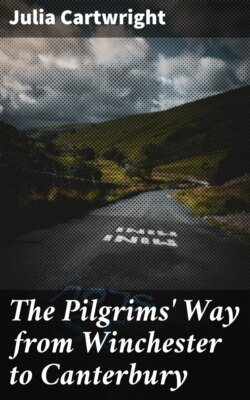Читать книгу The Pilgrims' Way from Winchester to Canterbury - Cartwright Julia - Страница 3
На сайте Литреса книга снята с продажи.
PREFACE
ОглавлениеTable of Contents
THIS account of the Way trodden by the pilgrims of the Middle Ages through the South of England to the shrine of St. Thomas of Canterbury originally appeared in the Art Journal for 1892, with illustrations by Mr. A. Quinton. It was published in the following year as a separate volume, and reprinted in 1895 and 1901. Now by the courtesy of Messrs. Virtue’s representatives, and in response to a continued demand, it appears again in a new and revised form, with the{vi} additional attraction of illustrations from original drawings by Mr. Hallam Murray.
During the twenty years which have elapsed since these pages were first written, a whole literature has grown up round the Pilgrims’ Way. Not only have scholarly papers on separate sections of the road appeared in the Journals of Archæological Societies, but several valuable works on the subject have been issued by writers of authority. Mr. H. Snowden-Ward has written a book on “The Canterbury Pilgrimages,” in Messrs. A. & C. Black’s Pilgrimage Series, in which he deals at length with the life and death, the cult and miracles of St. Thomas, and the different routes taken by pilgrims to his shrine. Mr. Palmer has described a considerable portion of the Way in his treatise on “Three Surrey Churches,” and only last autumn Mr. Elliston-Erwood published an excellent little guide-book called “The Pilgrims’ Road,” for the use of cyclists and pedestrians, in Messrs. Warne’s Homeland Pocket-book Series. But the most thorough and systematic attempt to reconstruct{vii} the route taken by pilgrims from Winchester to Canterbury has been made by Mr. Belloc in his admirable work, “The Old Road.” The author himself walked along the ancient track, and succeeded in filling up many gaps where the road had been lost, and in recovering almost the whole of the Way, “yard by yard from the capital of Hampshire to the capital of Kent.” This intimate knowledge of the road and its characteristics have led him to make several alterations in the line of the Way marked on the Ordnance Map, which had hitherto served as the basis of most descriptions. But as Mr. Belloc himself recognises, it is clear that pilgrims often left the original road to visit churches and shrines in the neighbourhood. Thus, in several places, new tracks sprang up along the downs to which local tradition has given the name of the Pilgrims’ Way, and which it is not always easy to distinguish from the main road. Like Bunyan’s pilgrims, when they came to the foot of the hill Difficulty, “one turned to the left hand, and the other to the right, but the narrow way lay right up the hill.”{viii}
In this edition of my book some obvious errors have been corrected, and certain doubtful points have been cleared up with the help of experience gained by other workers in the same field. But, as a rule, my object has been not so much to draw attention to the actual road as to describe the antiquities and objects of interest which arrest the traveller’s notice on his journey. From whatever side we approach it, the subject is a fascinating one. All of these different studies, varied in aims and scope as they may be, bear witness to the perennial interest which the Pilgrims’ Way inspires. The beauty of the country through which the old road runs, its historic associations and famous memories, the ancient churches and houses which lie on its course, will always attract those who love and reverence the past, and will lead many to follow in the footsteps of the mediæval pilgrims along the Way to Canterbury.
Julia Cartwright.
Ockham, Nov. 1, 1911.
{ix}
THE RIVER ITCHEN WHERE IT LEAVES THE TOWN.
